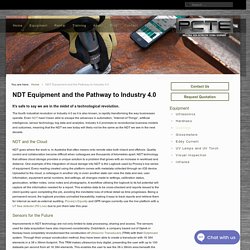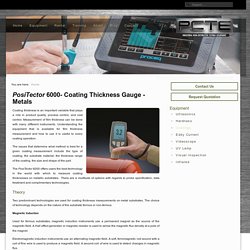

PCTE Industrial
PCTE Industrial is a specialist in the sale and hire of industrial non-destructive testing (NDT) equipment. PCTE INDT is a branch of PCTE, who have been serving in the NDT industry since 2008.
7 Points to Remember for Decreasing the Error During Eddy Current Measuring Techniques. Asset Integrity Inspection with Eddy Current Testing. Non Destructive Testing Equipment – RSS Feed. Composites and the Application of Non-Destructive Testing. What are composite materials?

As the name suggests composite materials are heterogenous, resulting from combinations of two or more distinct materials. In composite materials the combination of materials is at the macroscopic level, resulting in discrete interfaces separating the constituent elements. When we think of composite materials, polymer-based variants are usually the first to come to mind such as carbon fibre reinforced polymers or glass fibre composites. However, there are also naturally occurring composite materials such as wood.
Another commonly used but often overlooked composite material is concrete. The common impetus for developing and using composite materials is to create a material with a combination of properties that is not commonly achievable or practical in homogeneous materials. An example to illustrate a positive difference would be the use of ground penetrating radar (GPR) on concrete. NDT Equipment and the Pathway to Industry 4.0. It’s safe to say we are in the midst of a technological revolution.

The fourth industrial revolution or Industry 4.0 as it is also known, is rapidly transforming the way businesses operate. Even NDT hasn’t been able to escape the advances in automation, “Internet of Things”, artificial intelligence, sensor technology, big data and analytics. Industry 4.0 promises to revolutionise business models and outcomes, meaning that the NDT we see today will likely not be the same as the NDT we see in the next decade. NDT and the Cloud NDT goes where the work is. Sensors for the Future Improvements in NDT technology are not only limited to data processing, sharing and access. The Benefits of Visual Inspection Equipment. There may be more recent developments in devices and equipment for inspecting the condition of structures, but the most basic and oldest techniques can still be reliable.

Visual inspection. Also known as ‘visual testing’, it is traditionally known as the process of inspecting a particular area with the naked eye to find flaws. However, the process is now aided by visual inspection equipment, which can ensure more accuracy. By using Videoscopes, crack measuring tools, and crack cameras, you can speed up your inspection and deliver precise results to help you make informed decisions for your project. Visual inspection equipment increases productivity and minimises downtime. High-quality visual inspection equipment pieces are available from reputable retailers at competitive prices. Principles and Applications of Portable Hardness Testing. Principles and Applications of Portable Hardness Testing. Everything You Should Know About Portable Hardness Test - pcteindustrial.over-blog.com.
The portable hardness test is conducted using different kinds of methods, like the portable Leeb, Brinell, Rockwell, and Poldi hardness tests, as well as ultrasonic, and impact telebrineller tests.

Regardless of the method you use, it should be a non-destructive means to determine the hardness of a material. Hardness testing is particularly useful in manufacturing and construction to learn about the material’s characteristics and to check the quality of a particular material to ensure that it will meet a specific specification needed to ensure a durable structure. The portable hardness test allows you to measure and determine hardness on-site, even when the structure has already been constructed. Before portable devices were invented, conventional hardness testing involved large and bulky machines, which were difficult to bring on-site. Because of that, portable hardness testing devices were developed to enable quick and straightforward in-situ measurements of hardness. An Overview of Dye Penetrant Inspection. Non-destructive testing methods are cost-effective and will enable you to save a lot of time, money, and effort in getting the results you need to make informed decisions about your project.

One of these is the dye penetrant inspection (DPI) or dye penetrant test, which is specifically used to identify surface breaking flaws. Sometimes referred to as, ‘liquid penetrant inspection’ (LPI), this method can assist in detecting cracks, seams, laps, porosity, and other kinds of surface breaking voids. This inspection method can be used on non-porous materials both ferrous and non-ferrous, which includes materials such as ceramics, metals, and plastics. Eddy-Current. Positector 6000- Coating Thickness Gauge. Coating thickness is an important variable that plays a role in product quality, process control, and cost control.

Measurement of film thickness can be done with many different instruments. Understanding the equipment that is available for film thickness measurement and how to use it is useful to every coating operation. The issues that determine what method is best for a given coating measurement include the type of coating, the substrate material, the thickness range of the coating, the size and shape of the part. The PosiTector 6000 offers users the best technology in the world with which to measure coating thicknesses on metallic substrates.
There are a multitude of options with regards to probe specification, data treatment and complimentary technologies. Theory Two predominant technologies are used for coating thickness measurements on metal substrates. Magnetic Induction Electromagnetic induction instruments use an alternating magnetic field. Eddy Current How to select your gauge. Videoscopes. UV Lamps. Hardness. Ultrasonics. Industrial-NDT.